
Leading a Continuous Product Strategy Process
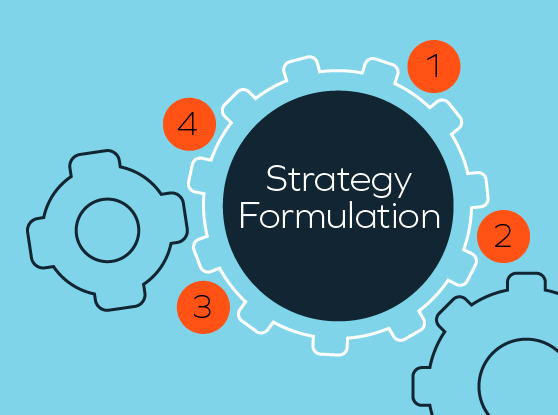
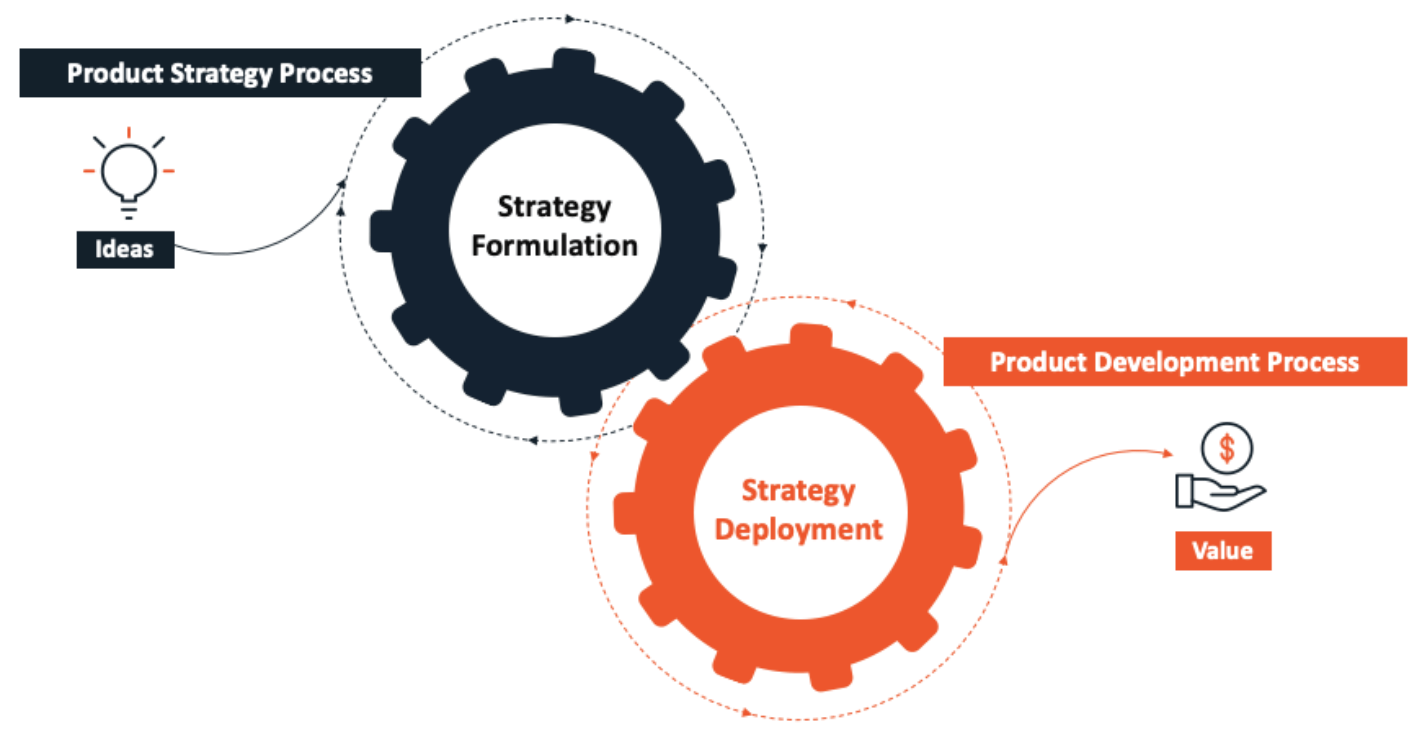
The path from StartUp to ScaleUp for a tech company is both thrilling and challenging. The current wins fuel future growth; possibility and opportunity abound. But at the same time, your business starts to grind – there is friction where there was smooth flow before. Things are harder than they should be. You may notice:
- The CEO has too much on their plate – they may want to maintain control of where the business and product are headed, but there are too many other priorities. They know they need to step back from product strategy but struggle to do so.
- Product ideas flourish but turning them into aligned execution is challenging.
- Engineering is executing well, but Sales is selling things that feel like they distract from our roadmap – Sales and Product aren’t aligned.
- We are running multiple Go-To-Market motions and we aren’t sure which is the right one.
- We are always behind the eight-ball when budgeting and operating plan time comes around.
- We need to build another product and we aren’t sure how to proceed.
- Everyone is saying we need to hire a CPO, but why? What will they do?
These friction points are symptoms of a product strategy problem. You are rich in ideas but organizing your growing business in a way to deliver strategically gets more and more challenging with every person and team you add. To evolve, you need to shift from a process for building product ideas to one for executing a product strategy. And you need the right leadership to make this transition.
How We Got Here
The fact that you are scaling means you have been successful – congrats! Your process for getting to this point may have looked something like this:
- CEO (or founder) has an idea
- Company focuses on getting product-market fit
- Get traction in the market
- Build what the market wants
Typically a member of your Executive Team will run the process of taking ideas and turning them into products. That will work for a while... until it doesn’t and you start losing momentum. Momentum drops because you aren’t executing against a product strategy, but instead are reacting to what customers and prospects are shouting for. Your roadmaps and execution plans are gut-based vs. evidence-based. Everyone is not on the same page. All of this speaks to the reality that you don’t have a real process for product management, and you need one.
How We Will Scale
The development of a product strategy is a product management process. We know, PROCESS. That word can send some folks running for the hills. But it really is a process – an annual cycle of defining and iterating and creating alignment. Our goal is not to be perfect at the process, but to create an environment where the Executive Team iterates each quarter and ends each year aligned on what we are doing next, while also establishing a clear roadmap that the rest of the business can successfully execute against today.
The definition of the product strategy process is best done by an experienced product leader – probably a CPO or facilitative Product Leader working with the CEO – who can define both the vision; setting the direction for the product, and be the facilitator; engaging the executive team in the process to ensure alignment and buy-in.
Continuous Product Strategy Process
In this example, we will map the process across a year and align it to quarterly planning cycles. The process can be run at different speeds, across different timelines, as needed. You may just need to modify your outputs to match your time and capacity.
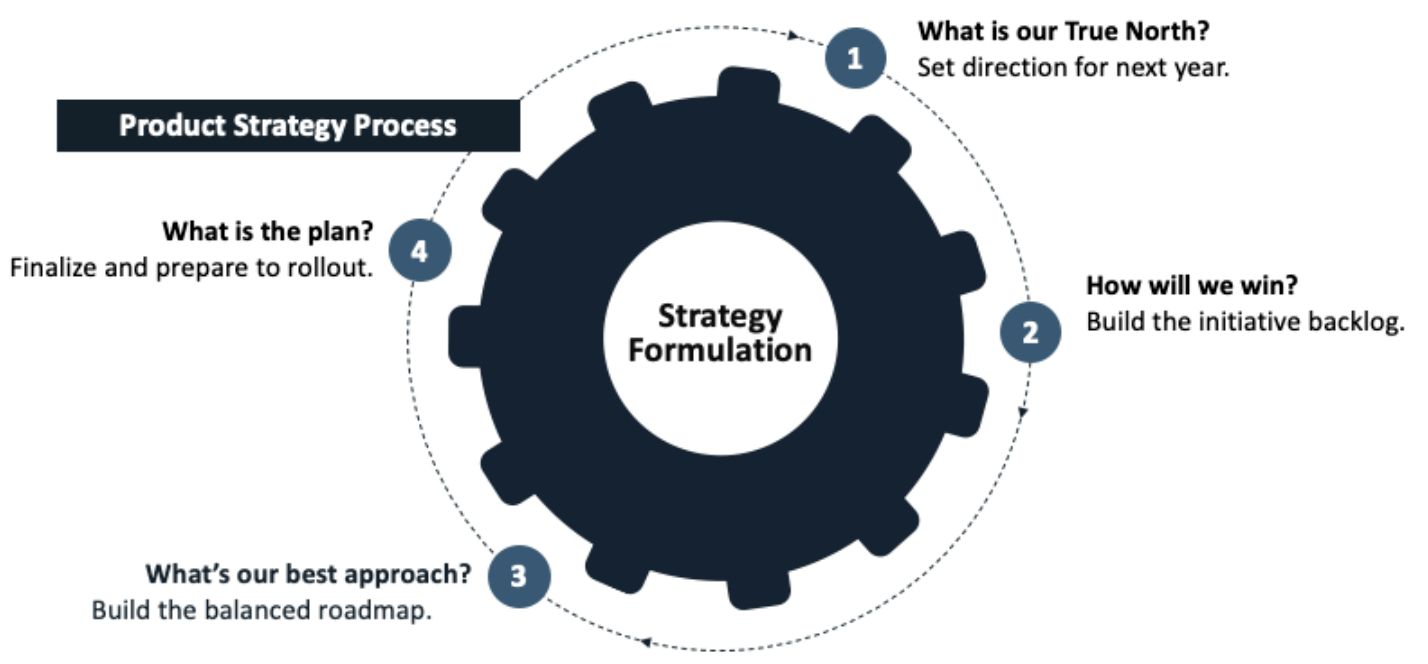
Step 1: What is our True North? (Annual Timing- end of Q4)
The Eteam gathers to align around a “winning aspiration” for next year. This can include mission, vision, and how we will win. We don’t need to re-up our vision every year – in fact that would be a symptom of bigger organizational issues. But we do want to revisit it and consider what it means for how we will win next. Doing this in Q4 ensures that we have time to work out any issues and disagreements so that we can enter Q1 ready to define our strategy for the next year.
Outputs: True North, strategies, vision, mission, strategic OKRs
Step 2: How will we win? (Annual Timing – Q1)
The Product Management team describes the market as it is today: competition; opportunities; ICP; buyer/user personas and changes in buying behaviors. If you haven’t done this before, your first round will define this rather than describing changes. This is typically collected in a single document containing all the market information to allow the Executive Team to “see the whole”. The structure is typically something like:
- Exec summary
- Defining our strategic problem
- Customer / Buyer segmentation
- ICP – multiple customer profiles
- Jobs to be done by segments
- Reference customers
- TAM
- Products to customer segments
- Segmentation to TAM
- May have some buyers that span profiles
- How is the TAM in each segment shifting – growth compared to the market (faster, slower, equivalent)
- Segment SWOT
- Helps you know where to focus in your customer segmentation
- Competitive analysis
This is research and it takes work to answer the questions. Your Product Management leaders will do research, create variables, and once they have gathered the information, they will bring leaders from across the organization together to discuss and iterate and negotiate and clarify and align – it's an activity, not a readout. The discussion typically includes the CEO, CFO, CRO/EVP Sales, CMO – whoever your executive team is. The key is that it is cross-functional leadership.
Outputs: Detailed market data and agreement on the customer, buyer, user, and other segmentation and personas along with agreement on where to play.
Step 3: What’s our best approach? (Timing – Q2)
Now we take what we learned in our discussions and negotiations and create a thesis on our best approach to winning in this market. The Product Management team drafts the thesis and brings it back to the leadership team. This involves a series of facilitated sessions to discuss and iterate. Our goal is to be aligned on what we “could do” - which we will represent as initiatives. The meetings may involve activities like SWOT analysis, ideation, and other strategic activities.
Outputs: Backlog of initiatives we could invest in in the next year(s).
Step 4: What is the plan? (Timing – Q3)
The leadership team iterates with the Product Management team on building a prioritized and sequenced roadmap of initiatives while considering all the work that has come before: SWOT analysis; ICP; competitive landscape; strategic innovation. Additionally, we need to consider what capabilities must be in place and what management systems are required for us to be successful in delivering these initiatives.
Topics to be discussed may include:
- How must we adjust our GTM motion: ways we serve our customers; pricing and packaging; what growth approach will we take (e.g. PLG or sales-led)?
- Analysis of multiple paths and/or scenarios – given our capacity and opportunities, how many teams will we need?
- What are we going to say “not yet to” in order to meet our goals?
Outputs: Roadmap of initiatives along with departmental plan to support the rollout of new products and features across the year.
Cadenced Alignment Process: Transition to execution
Finally, we are ready to deliver a plan for the coming year. This shouldn’t be complex or challenging as we are well prepared based on the product strategy work we have done in Q1-Q3. We know the CFO and CEO will want a budgeting and operating plan for next year. Sales will be asking us to prep for SKO in Q1. Our ability to both influence and align to these planning cycles is improved because of our work. We feel confident in our plans because they are based on evidence and hard work, not just our gut.
In all of this, the Product Management team walks a fine line of doing research, building drafts, guiding conversation and debate; having an opinion but being open to alternative answers. The team has “strong beliefs that are loosely held”.
Outputs: finalized budget, operational, GTM, and product plans for the coming year. Along with an expectation that evolution and steering will occur each quarter.
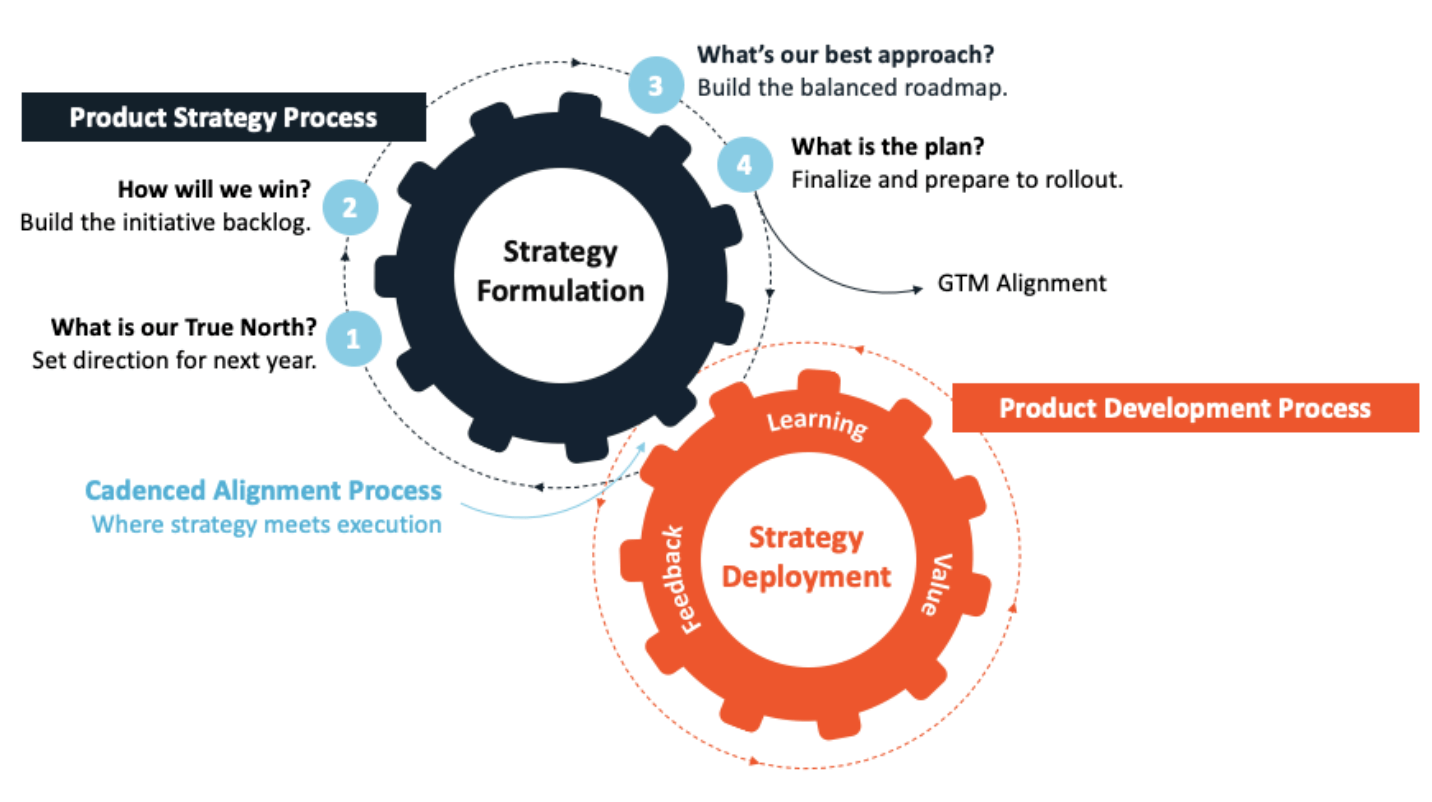
The transition to execution allows our best-laid plans to convert to reality – and there will be changes. As the product development process deploys the strategy, there will be ongoing feedback and learning from the creation of value that the Executive team needs to be tuned into in order to steer the current plan and design the future.
Regular touch points with the product development process are vital to our success – the Executive Team keeps fueling the development engine and steering the focus based on current information and their vision for the future. Product Development moves quickly, taking the high level initiative roadmaps and breaking them down into executable features, managing capacity and priorities, cross-team planning, and continuously executing and learning.
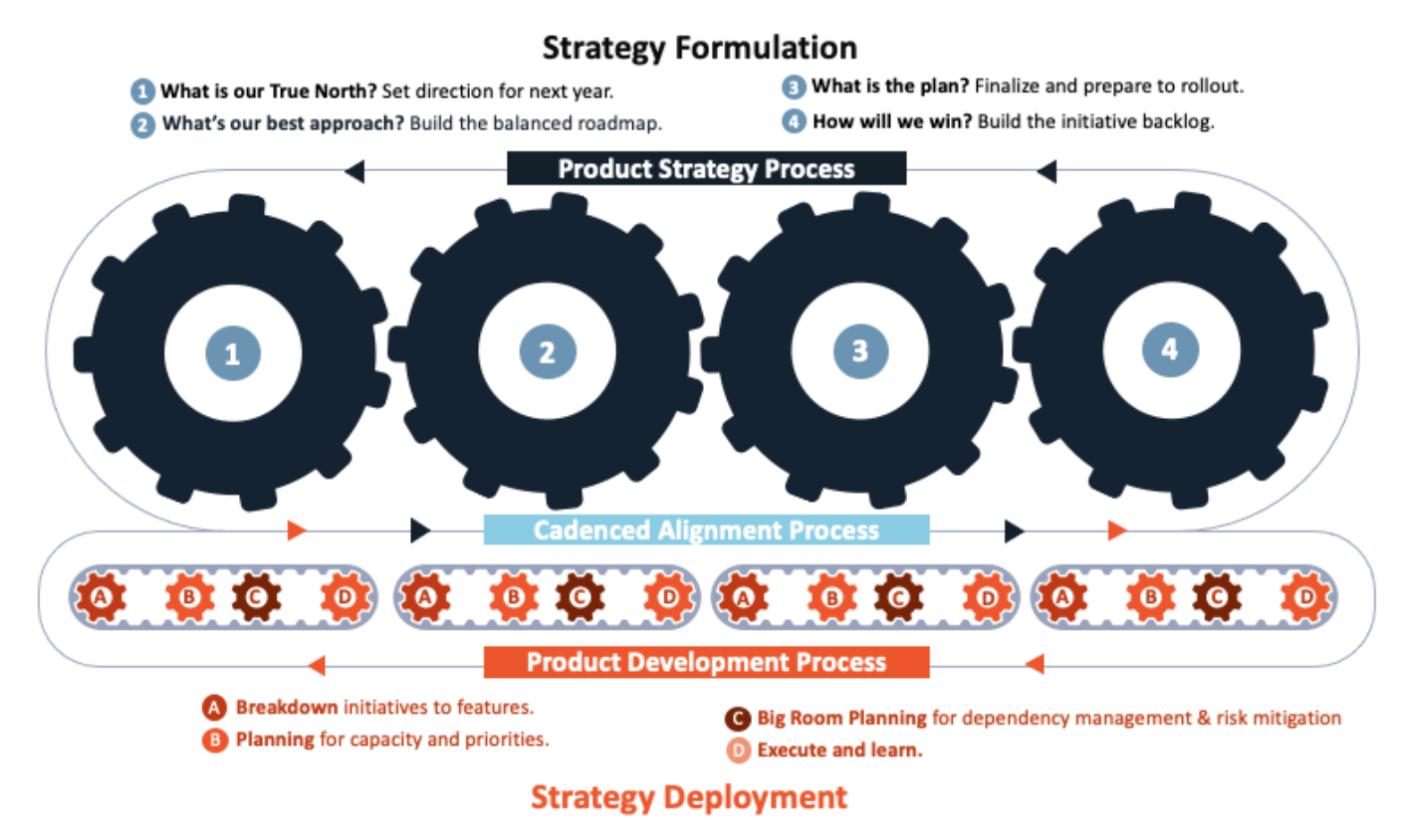
Turning your product ideation focus into a scalable product strategy process takes leadership and skill. You will be implementing a disciplined set of activities into a fast-moving organization that is rapidly scaling and changing. The best person for the job will be a facilitative Product Leader who is able to orchestrate the design and rollout of your upgraded processes and systems in order to build discipline around both Strategy Formulation and Deployment. Meanwhile, they will also be growing the core capabilities of the product management organization to balance internal product leadership and insight with evidence-based market insights.
It’s never too late to get started. Regardless of the time of year, consider the process laid out above and jump in, accomplishing as much as you can before your next product development cycle begins. Then start smoothing out the flow of your process over the next year.
If you have questions or want support on building out your Product Strategy Process, reach out to the Insight Onsite team at product@insightpartners.com. We are also linking to a suite of tools, templates, and examples for your reference.
Product Strategy Kit
Complete this form to download and access tools, templates, and examples to help you on your journey in building out your product strategy process.










